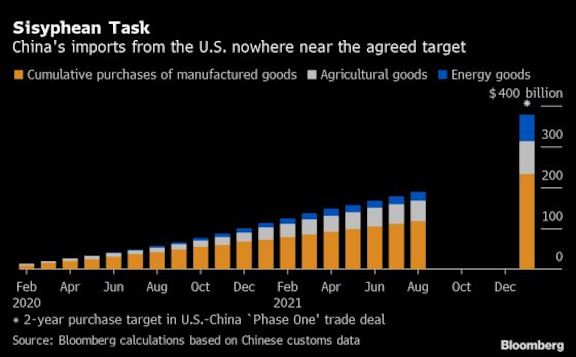Biden’s economic concerns on China go beyond trade promises, Tai says
The U.S. is raising concerns with China that go beyond the nation’s purchasing commitments under their existing trade deal, including Beijing’s state-centered industrial policy, President Joe Biden’s chief trade negotiator said.
U.S. Trade Representative Katherine Tai said that the administration “sooner rather than later” will move beyond its current first step of engagement with China, which includes discussion of the so-called phase-one deal from January 2020. Some parts of the agreement are set to expire at the end of this year.
China is far behind its purchasing targets, in which it pledged to buy an extra $200 billion in U.S. agriculture, energy and manufactured products over the 2017 level in the two years through the end of 2021.

“We’re raising with China our continuous concerns about the impacts of its extremely robust and very effective industrial policies on our ability to grow, on our ability to compete, on our ability to thrive,” Tai told reporters in Washington Wednesday. “That is a larger conversation that we feel very strongly that we have to have. It’s not necessarily reflected in the phase-one agreement.”
Washington and Beijing are at odds on economic, military and political fronts. Flashpoints include billions of dollars in tariffs on each other’s goods, U.S. concerns about China using American technology know-how to beef up its military, abuse of state-owned enterprises, subsidies, forced-labor allegations in the Xinjiang region, and conflict over supplying next-generation telecommunications equipment to other nations.
President Xi Jinping and his lieutenants have elevated the role of technology and high-value-added manufacturing and technology in China’s economic policy making, directing resources to areas including artificial intelligence and semiconductors. Beijing is also pursuing “civil-military fusion,” or the innovation of dual-use products that can help China’s military and its corporate champions to surpass overseas rivals.
Tai met with virtually with Chinese Vice Premier Liu He in early October to kick off discussion of the trade relationship between the world’s two biggest economies and the 2020 trade deal, officially known as the U.S.-China Economic and Trade Agreement.
The pact called for Beijing to make changes to regulations on intellectual property and other areas, and had specific targets for Chinese purchases of U.S. goods. Bloomberg calculations show that China has only bought half of the goods it promised to purchase so far.
U.S. consumer prices rose 6.2% in October, the fastest annual pace since 1990. When asked whether faster U.S. inflation would be an impetus for rebalancing or removing some of the so-called section 301 tariffs on more than $300 billion of annual imports from China, Tai said that the administration is “looking at the big picture.”
“All of that is about the U.S. positioning itself in this relationship with China in the global economy to seek out the most advantageous position for us to remain competitive and to be able to thrive,” Tai said.
China’s performance under its trade agreement with the U.S. “hasn’t been perfect,” Tai said. “So what do we do about it? That’s the million-dollar question,” she said. “It’s something we’re working on,” she added. “We’re optimistic in our work.”
Similar Stories
December CNBC/NRF retail monitor results show strong growth boosted by final Thanksgiving weekend days
Retail sales jumped strongly in December, boosted in part by two busy holiday shopping days during Thanksgiving weekend falling in the final month of the year, according to the CNBC/NRF…
View ArticleNAW presents Dirk Van Dongen Lifetime Achievement Award to Bergman, CEO of Henry Schein, Inc.
At the 2025 NAW Executive Summit Gala on January 28 in Washington, D.C.
View Article
St. Louis region’s chemical industry welcomes new investment
View Article
Navigating compliance: Adapting to changing Customs regulations in global supply chains
View Article
December 2024 U.S. Transportation Sector Unemployment (4.3%) Was the Same As the December 2023 Level (4.3%) And Above the Pre-Pandemic December 2019 Level (2.8%)
View ArticleDP World appoints Jason Haith as Vice President of Freight Forwarding for U.S. and Mexico
DP World, a global leader in logistics and supply chain solutions, has announced the appointment of Jason Haith as Vice President, Commercial Freight Forwarding – U.S. and Mexico, effective immediately.…
View ArticleGet the most up-to-date trending news!
SubscribeIndustry updates and weekly newsletter direct to your inbox!





